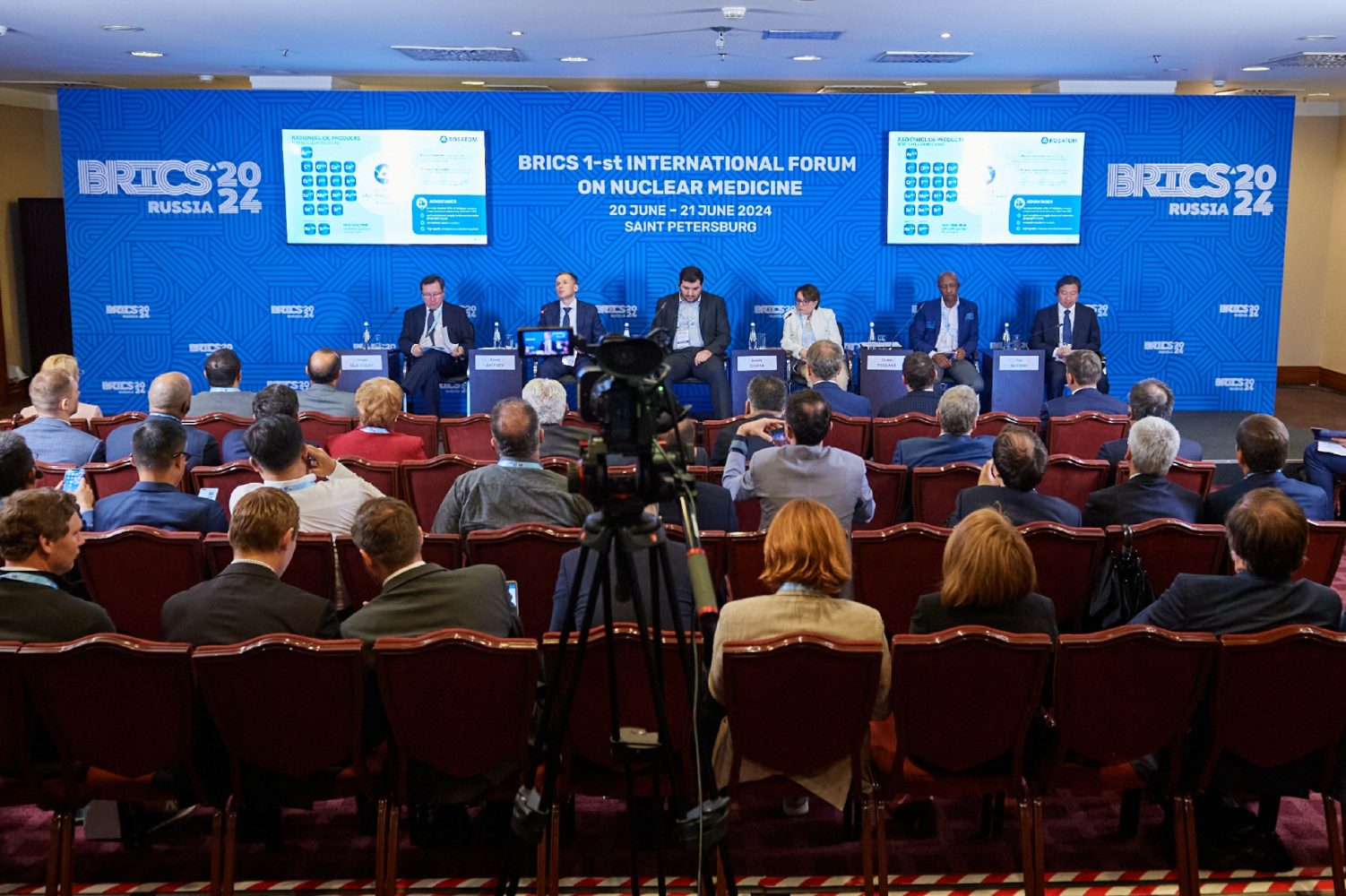
Isotope Interaction
back to contentsIn late June, Saint Petersburg hosted the first BRICS International Forum on Nuclear Medicine. Co-organized by Rosatom, the forum brought together over 250 experts from the BRICS countries to discuss the current challenges in this field.
Welcoming the participants, Russian Deputy Prime Minister Tatyana Golikova stated the need for the member countries to adopt a common strategy for the development of nuclear medicine, including common approaches to the treatments and application of radiopharmaceuticals (RPs). She proposed to concentrate efforts on three areas. First, the BRICS countries need to strengthen technological sovereignty by increasing domestic production of RPs and related equipment. Second, they should promote nuclear medicine technologies both within the BRICS and beyond. Third, the member countries should increase mutual trade in nuclear medicine.
To achieve these goals, Tatyana Golikova suggested identifying the most promising areas for scientific and technical cooperation and production of innovative RPs, as well as compiling and publishing a review of BRICS best practices in nuclear medicine.
Russian Health Minister Mikhail Murashko noted that the best practice review would be published by the 14th BRICS Health Ministers’ Meeting scheduled for October this year. “Initiatives of the BRICS countries can lay a foundation for the global healthcare architecture,” the Minister pointed out. The brochure will be submitted to the UN, WHO, International Agency for Research on Cancer, and IAEA.
Mikhail Murashko said that radiopharmaceuticals were included into the priority technology list approved by the President of the Russian Federation. Every year, over 800 thousand diagnostic procedures are carried out in Russia under the Fight against cancer federal project. These procedures are covered by public health insurance and free of charge for Russians. Radio pharmacies have been established to build an end-to-end supply chain, spanning from the fabrication of isotopes to the sale of ready-to-use RPs. The regulatory framework has been modified in Russia and the EAEU to ease patients’ access to the latest nuclear medicine solutions. Mikhail Murashko suggested that the BRICS countries should jointly conduct research and develop new RPs.
Yury Olenin, Deputy Director General for Science and Strategy at Rosatom, said that nuclear medicine was a priority business for the Russian nuclear corporation. Rosatom builds infrastructure for medical care, produces and supplies medical isotopes and radiopharmaceuticals, creates equipment for diagnostics and therapy, and develops irradiation solutions for medical products. In particular, Rosatom accounts for up to 90 % of isotope supplies in Iran, a third in Brazil, 22 % in China, and 13 % in India.
Yuri Olenin emphasized the importance of harmonizing national rules for pharmaceutical supply chains, preclinical and clinical trials, etc.
As noted by Boris Dolgushin, a member of the Russian Academy of Sciences and Director of the Institute of Clinical and Experimental Radiology of the N. N. Blokhin Cancer Research Center, Russia has much to offer the BRICS countries in nuclear medicine. The first thing is education as Russia, one of the leaders in this field, can provide training under the IAEA programs. The second is equipment, including nuclear reactors, accelerators and cyclotrons. Third come nuclear materials and, finally, new technologies. For example, a boron neutron capture therapy device is being installed at the Blokhin Center to become operational by the end of this year.
Prabhu Ethiraj, Director of the Nuclear Medicine Institute at the Government Multi Super Specialty Hospital and President of the Society of Nuclear Medicine India, said that India had seen an explosive growth of nuclear medicine since 1970. About 80–90 % of nuclear medicine organizations are private in India. “This provides an opportunity to develop technology and creativity in nuclear medicine,” Prabhu Ethiraj explained. The government has taken over the training of nuclear medical workers.
Rafael Lopes, Director of the Nuclear Medicine Department at the Cardiology Hospital and President of the Brazilian Society of Nuclear Medicine, spoke about the use of RPs in cardiology. It accounts for about a million diagnostic procedures per year, which is half of the total. The most common procedure is SPECT because it is relatively easy and inexpensive. The challenge for Brazil is to increase the number of PET scanners and PET procedures but the country needs expensive rubidium generators for this purpose. “We need to think together about how to make nuclear medicine solutions affordable so that patients live longer and healthier lives,” Rafael Lopes suggested.
Mohammadreza Davarpanah, CEO of Pars Isotope (Iran), said he saw potential in using different combinations of alpha and beta isotopes. The country plans to double its SPECT fleet (over 220 machines so far) and install up to 60 PET scanners. The country produces around 60 RPs, more than half of which are diagnostic. 18 new products are in the clinical trial phase, with another eleven in the initial research phase. “We will be happy to help other countries with research and development. This is very important because cancer is our common enemy,” Mohammadreza Davarpanah summarized.
Representatives of leading nuclear medicine organizations from China, South Africa, Egypt and Saudi Arabia also shared their experience.
A total of 16 sessions were held at the forum to discuss the production of basic radionuclides, innovations, registration of RPs, various nuclear medicine solutions, their application in cardiology and endocrinology, and other issues. The results of the forum will set the framework for discussions on nuclear medicine at the BRICS Summit to be held in Kazan (Russia) on October 22–24, 2024.




